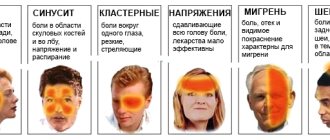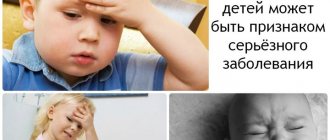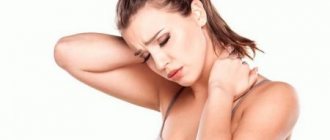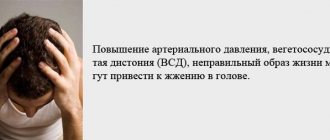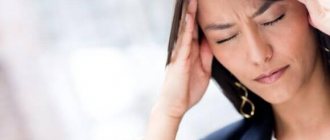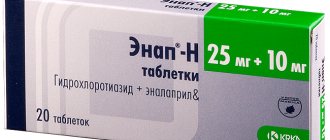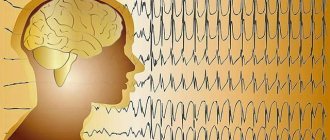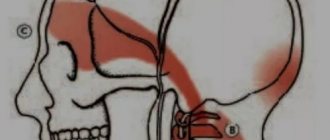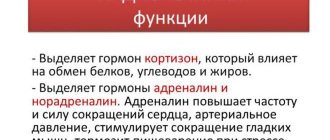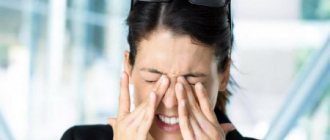If severe pain appears in the temples and back of the head, it is recommended to undergo a comprehensive examination. Uncontrolled use of medications can only worsen the clinic and the patient’s condition.
With constant use of analgesics, the intensity of pain in the temples and back of the head increases. At the same time, the frequency of manifestations of the syndrome increases.
Cephalgia is diagnosed at any age, and if left untreated, it can cause serious disturbances in the functioning of the body.
Why does my head hurt?
A severe headache can occur due to various reasons. Every person has encountered this unpleasant syndrome at least once in their entire life. In most cases, pain in the head is periodic, short-term in nature and is not evidence of the development of a serious illness. It is necessary to listen to the body in cases where acute discomfort often bothers you and is not relieved by the usual painkillers.
Depending on the root cause, the following types of disease are distinguished:
- Migraine. During migraine attacks, one-sided pain in the right or left temple is often disturbing. Other signs: nausea, photophobia, intolerance to certain smells, loud sounds, general weakness. A migraine can last from a couple of hours to several days.
- Tension headache. A frequently diagnosed pathology, mostly of low intensity, but can be a regular concern. The nature of the syndrome is pressing or compressive, spreading over the entire head, but sometimes it is localized in a separate part - the area of the back of the head, forehead, crown. The syndrome occurs in men and women who constantly experience muscle strain.
- Cluster headache. One of the most severe types of disorder, in which a person is bothered by excruciating throbbing pain in the temple, back of the head, forehead or eyes. The causes of this pathology are not fully understood, but doctors believe that cluster headaches manifest themselves against the background of pathological activity of the hypothalamus.
- Headache caused by infection. The syndrome occurs with acute respiratory infections, acute respiratory viral infections, and is accompanied by fever, cough, rhinitis, and sneezing. A person is often bothered by a headache in the temples of moderate intensity. After taking antipyretic and painkillers, the condition returns to normal. When infected with meningococcal infection, a high temperature lasts for a long time, throbbing pain in the back of the head is bothersome, and other symptoms appear: nausea, vomiting, fog.
- Post-traumatic pain. It is a consequence of severe injuries suffered. An unpleasant symptom is localized at the site of injury, bruise, or other damage. When a concussion occurs due to increased ICP, pressing pain in the temples, attacks of nausea, and vomiting appear.
- Sinus pain. It is a concern when there is inflammation of the nasal mucosa and is accompanied by additional symptoms: swelling, rhinitis, nasal congestion. The pain is localized in the forehead and near the nose. It may bother you until the disease is completely cured.
- Head pain that occurs due to high intracranial pressure. The symptom is intense, painful, oppressive in nature, affects the entire surface of the head, but can be localized in the eye area. It is more often diagnosed in people who have suffered a head injury, as well as those who have injuries received during childbirth.
- Headache associated with inflammation of the trigeminal nerve. The syndrome is painful and usually lasts a few seconds. The pain can be localized in the back of the head on the right or left, in the temples, forehead. Damage to the trigeminal nerve can provoke untreated caries, chronic stomatitis, sinusitis, malocclusion and other dental problems affecting the oral cavity.
Diagnostics
Pain in the temples can signal pathological processes in the head, which can be identified using the following methods:
- Interview and examination by specialists such as a therapist, neurologist, otolaryngologist, ophthalmologist and dentist.
- Electroencephalography to analyze the activity of the central organ of the nervous system.
- X-ray for diagnosing head injuries, hydrocephalus.
- MRI to determine the presence of tumors and detect circulatory disorders.
- Computed tomography to detect tumors and hemorrhages in the main organ of the central nervous system.
- Laboratory tests to determine the presence of infections and assess the condition of the blood.
- Ultrasound of the brain to detect atherosclerosis and vascular abnormalities.
Headaches in the temple area
Headaches in the temple area
Severe pain in the temples occurs for various reasons. In some situations, temporal pain is considered a characteristic sign that allows the doctor to determine the diagnosis at the initial stage of development of the pathology. Therefore, if the syndrome recurs regularly, it is better not to self-medicate and visit a specialist as soon as possible. To find out the root cause of the disorder, the doctor will refer you for a comprehensive diagnosis, the results of which will help you choose the most effective treatment regimen.
Causes
Common reasons for pain in both the left and right temples:
- Infection with a viral or bacterial infection. After entering the body, viral or bacterial pathogens begin active life, releasing decay products into the patient’s blood. This leads to general intoxication and the development of characteristic symptoms: headaches, nausea, and sometimes vomiting.
- Sleep problems. Throbbing pain in the temples may be a consequence of chronic lack of sleep. In such situations, a person is constantly overtired, thought processes are slow, and as a defensive reaction a headache occurs in the right or left temple.
- The onset of menstruation. Pain localized in the right temple or the left often bothers women before menstruation. This is due to changes in hormonal levels, which can negatively affect women’s well-being. After the hormonal levels stabilize, the unpleasant discomfort will disappear.
- High psycho-emotional stress. Occurs against a background of severe stress or chronic fatigue.
- Meteosensitivity. Sudden weather changes negatively affect the condition of groups of people suffering from increased weather sensitivity.
Symptoms
Depending on the degree of tolerance, pain in the temples can be:
- Weak. A barely noticeable symptom that does not affect the general well-being and performance of a person. It goes away on its own, without taking painkillers.
- Strong. A severe headache in the temples is difficult for patients who are forced to take a break from everyday activities and begin treatment. After using painkillers, the condition does not immediately return to normal.
- Intolerable. Pain in the left or right temple cannot be relieved with conventional medications. The patient's condition is rapidly deteriorating, and professional medical care is indispensable.
Possible diseases
Pain localized in the left or right temple may indicate the development of the following diseases in the body:
- Hypotension. A sudden drop in blood pressure is accompanied by an increase in dull pain in both temples. Additional symptoms: weakness, lethargy, tremors of the limbs, tinnitus, cold sweat.
- Hypertension. With a sharp increase in blood pressure, a sharp headache and pulsation in the temples bother you. Associated symptoms: nausea, vomiting, facial flushing, increased sweating.
- Adrenal diseases. The adrenal glands are paired glands of the endocrine system. Violation of their functioning leads to serious disruptions in the body. Some complications are accompanied by severe pain in the temples.
- Osteochondrosis of the cervical spine. With degenerative-dystrophic processes in the cervical vertebrae, pain in the neck and back of the head is bothersome; discomfort often spreads to the parietotemporal zone.
- Vasoconstriction. It can result from vascular spasm, neurocirculatory dystonia, and atherosclerotic changes. Men and women may be bothered by shooting pain in the left and right temples, darkening of the eyes, tinnitus, and mental fog.
Diagnostics
To find out the causes of regularly recurring pain in the temples, you must first consult a doctor, who, after examining and collecting an anamnesis, will refer you for a comprehensive diagnosis. The following diagnostic procedures will help determine an accurate diagnosis:
- Ultrasound of head and neck vessels with Doppler;
- CT or MRI of the head and cervical spine;
- electroencephalography;
- X-ray of the cervical spine.
Treatment
The treatment regimen is determined by the doctor based on the examination results and the established diagnosis. If the causes of pain in the temples are not associated with serious illnesses, the doctor will prescribe an anesthetic drug that will help relieve pain at the initial stage of progression.
If pain in the temples occurs against the background of serious illnesses and malfunctions, the doctor draws up a treatment plan aimed at eliminating the underlying pathology. After the underlying disease is completely cured, the headache will disappear on its own, without the use of special medications.
Diseases of the brain and blood vessels
Diseases of the brain and blood vessels
Vascular diseases of the brain are often the main cause of prolonged, intense headaches that recur at regular intervals. Damage to the blood vessels of the brain leads to impaired blood circulation and the development of hypoxia, which becomes the root cause of poor health.
Common vascular diseases of the brain:
- Atherosclerosis. Develops against the background of lipid metabolism disorders. With this disease, a fatty substance forms on the inner walls of blood vessels, which narrows the lumen, disrupting normal blood circulation.
- Aneurysm. Local dilatation of cerebral vessels, which can cause rupture of the vascular walls.
- Hemorrhagic and ischemic stroke. Deadly vascular pathologies, accompanied by damage to brain vessels and internal hemorrhage.
- Acute hypertensive encephalopathy. It develops against the background of a sharp increase in blood pressure and is characterized by intense prolonged cephalalgia, blurred vision, confusion, and unbearable headaches.
Brain diseases accompanied by severe headaches:
- Meningococcal infection. A deadly infectious disease that affects the tissues of the brain. Characteristic signs: temperature rise to critical values – 39 – 40 °C, unbearable headache, weakness, nausea, vomiting, fog.
- Encephalitis. Inflammation of the brain that develops when the tissues of the gray matter are damaged by a viral infection. Characteristic signs are high fever, headache, weakness, disorientation.
- Brain abscess. A severe complication in which there is a local accumulation of purulent masses in the gray matter. Signs of pathology: headache, lethargy, fever, neurological disorders.
- Tumor processes. A malignant or benign tumor located in the brain, constantly increasing in size, begins to compress the nerve endings that penetrate the gray matter. As a result, a person begins to experience pain in the head, the intensity of which increases as the tumor grows.
Risk factors and main causes of the disease
If you have symptoms of Meniere's disease and the diagnosis has been confirmed from a medical point of view, it is advisable to follow certain lifestyle principles to reduce and mitigate the signs of the disease, non-compliance with which, as indicated by some sources, is the main cause of the disease. Ensure that you get enough sleep (i.e., at least 8 hours a day), avoid stressful situations, limit your salt and coffee intake, try not to drink alcoholic beverages, and stop smoking.
Headaches in the back of the head
Headaches in the back of the head
A headache in the back of the head can be a consequence of an injury. But the victim knows this for sure and will explain to the doctor the cause of the unpleasant syndrome. If the nature of the discomfort is inexplicable, then for effective treatment it is necessary to first find out the causes of its occurrence and try to eliminate them.
Causes
Discomfort in the back of the head is caused by:
- Chronic stress. When stress is prolonged, brain function is disrupted, immunity suffers, and a person begins to experience annoying headaches in the back of the head.
- Incorrect head position while sitting. When, during physical activity or sedentary work, the head is held in one position most of the time, this causes muscle strain, pinching of nerves and blood vessels. This condition is called tension headache.
- Nervous overstrain. Nervous overload often causes headaches in modern people who face stress every day, have an irregular work schedule, and suffer from lack of sleep and fatigue.
Other reasons for pain in the back of the head on the left or right:
- diseases of the central nervous system;
- cardiovascular pathologies;
- damage to the jaw apparatus;
- infectious processes.
Symptoms
Depending on the cause, pain in the back of the head on the right and left may have a different nature and degree of intensity. With organic lesions, the symptom gradually increases, becomes intense, and it becomes problematic to relieve it with usual medications each time. These headaches interfere with work and daily tasks.
Possible diseases
Diseases that can cause pain in the occipital area of the head:
- Arterial hypertension. If the symptom appears predominantly in the morning, after sleep, this may indicate the development of hypertension. People who suffer from frequent morning headaches should monitor their blood pressure and, in case of sudden increases, take antihypertensive drugs prescribed by their doctor.
- Diseases of the cervical spine. This includes osteochondrosis, spondylitis, sprains and subluxations of intervertebral joints. Pain in the back of the head with such lesions becomes more intense with any movements of the head and turns of the neck. Additionally, dizziness and spots before the eyes may bother you.
- Vertebrobasilar syndrome. Often occurs against the background of progression of cervical osteochondrosis. The main signs of the pathology: constant pain in the back of the head, dizziness, tinnitus, visual and hearing disorders.
- Cervical spondylosis. The pathology is caused by deformation and proliferation of osteophytes - pathological processes formed on the sides of the vertebrae. The disease is more often diagnosed in older people, but younger patients who lead a sedentary lifestyle also experience it. With cervical spondylosis, a headache occurs that covers the entire occipital area. The patient also complains of acute pain in the upper shoulder girdle, impaired vision and hearing. At rest, the syndrome subsides, but during activity it develops again.
- Cervical migraine. This disease is accompanied by pain in the back of the head, temples, and brow ridges. In this case, the patient complains of tinnitus, spots before the eyes, and dizziness.
- Neuralgia of the occipital nerve. The complication often develops against the background of advanced cervical osteochondrosis or spondyloarthrosis. Symptoms: pressing pain in the back of the head, spreading to the neck, upper back, lower jaw. Any movements of the head and turns of the neck cause an exacerbation of the symptom.
- Lymphadenitis. Inflammation of the cervical lymph nodes, the progression of which causes pain in the neck and back of the head, as well as under the jaw.
Diagnostics
The doctor will tell you how to relieve pain in the back of the head after studying the results of the diagnostic examination. For this purpose the following is carried out:
- initial examination, palpation;
- general clinical blood test;
- electrocardiogram;
- Ultrasound of the heart, neck and head vessels with Doppler;
- electroencephalography;
- X-ray of the cervical spine.
Treatment
After determining the exact diagnosis, individual treatment is selected, aimed primarily at eliminating the root cause of the pain syndrome. Treatment options:
- For neurological pathologies, proper rest and taking sedatives and painkillers are recommended.
- For cardiovascular diseases, medications are prescribed that normalize blood pressure and strengthen the heart muscle and blood vessels.
- For degenerative-dystrophic processes, non-steroidal anti-inflammatory drugs, muscle relaxants, and chondroprotectors are prescribed. Physiotherapeutic techniques, physical therapy, and manual massage can also be additionally used.
- For infectious and bacterial processes, antiviral drugs, antibiotics, and medications that eliminate associated symptoms are prescribed.
Treatment
The features of the treatment of cephalalgia are determined by the reasons for which it was caused.
Most often, patients are sent to a neurologist’s office, but during diagnosis it may turn out that the roots of the problem begin in a completely different place.
In this case, the patient will be sent to a specialist of a completely different profile, who will take into account all the features of the disease and prescribe the necessary medications and procedures.
For throbbing headaches, the following treatment methods are prescribed:
- Medication. The patient is prescribed anti-inflammatory or painkillers. Most often these are NSAIDs (non-steroidal anti-inflammatory drugs). These include: acetylsalicylic acid, Ibuprofen, Paracetamol, Diclofenac. The drugs are prescribed in the form of tablets and injections. In more severe cases, a long course of treatment using hormonal agents is required. They can be taken strictly as prescribed by a specialist.
- Manual therapy. This is an additional treatment method that is prescribed along with medications. The doctor will determine the area where the throbbing pain is most severe and help the patient relieve it. Most often, this treatment method is prescribed to relax patients and relieve throbbing pain from migraines.
- Massage. Prescribed to relieve discomfort caused by injuries. Helps relieve pulsation during migraines.
- Acupuncture. The specialist finds special points and acts on them using short-term acupuncture. Thanks to this, the internal organs associated with the nerve endings in this area become active. This helps alleviate pain, but only works in conjunction with manual therapy.
- Physiotherapy. Prescribed to relieve headaches caused by osteochondrosis, trauma or nervous strain.
An additional method of treating cephalalgia can be folk remedies: various lotions, decoctions, scented candles.
Prevention of headaches in the temples and back of the head
Prevention of headaches in the temples and back of the head
The best prevention of a disease is to find out the causes of its occurrence and completely eliminate them. Therefore, if symptoms recur regularly, you should not self-medicate and visit a doctor as soon as possible. After determining the diagnosis, the specialist will select an individual treatment regimen aimed at completely curing the pathology.
To prevent relapses, it is recommended to follow these simple general rules of prevention:
- try to eliminate stress factors from life;
- normalize your daily routine, get proper rest, get enough sleep;
- to refuse from bad habits;
- balance nutrition;
- increase immunity;
- involve moderate physical activity, spend more time in the fresh air;
- Visit your doctor periodically for a preventive examination.
People's Councils
If the unpleasant syndrome is caused by stress and nervous fatigue, an infusion with pharmaceutical chamomile, which has a calming, antispasmodic, and analgesic effect, will help alleviate the condition. The recipe for quick chamomile infusion is simple:
- Place 1 tsp in the teapot. dried chamomile flowers and pour 250 ml of boiling water.
- Cover the container with a lid and leave for 10 minutes.
- The finished product can be drunk with honey 2 – 3 times a day.
Some people find relief from headaches using compresses and lotions made from the following herbal ingredients:
- cabbage leaf;
- crushed leaves of peppermint, coltsfoot;
- chopped onion;
- lemon juice;
- ginger root, crushed to a paste;
- slices of unpeeled raw potatoes.
Spicy herbs help cope with migraines:
- basil;
- thyme;
- Melissa;
- marjoram;
- rosemary;
- fennel;
- lavender, etc.
If the headache is caused by high blood pressure, a warm foot bath with the addition of sea salt will help normalize the levels. You need to take a bath for 15–20 minutes, then put warm woolen socks on your feet and wrap yourself in a blanket. The procedure will help dilate blood vessels and normalize blood flow.
When to see a doctor
It is necessary to seek medical help for prolonged, incessant headaches that recur at regular intervals. The accompanying signs listed below most likely indicate a serious pathology, the treatment of which is dangerous to delay.
You should urgently call an ambulance if, in addition to a headache, you experience:
- changes in sensitivity in the upper and lower extremities;
- impairment of auditory and visual functions: noise, ringing in the ears, spots, dark spots in the eyes, photophobia;
- difficulty speaking;
- pathological changes in consciousness and memory;
- drowsiness, disorientation;
- increased body temperature, fever;
- lightning headache;
- pain in the temples and jaw when chewing;
- loss of consciousness;
- tremor of the limbs, cold sweat, paleness of the skin.
Maintenance therapy for the disease
In the event of an attack, the sick person should immediately lie down and remain completely calm.
Anti-nausea and dizziness medications should be taken immediately, so it is advisable to carry them with you. If during an attack there is pain in the temples or the back of the head, you can take a regular pain reliever. Lifestyle changes that every person diagnosed with Meniere's disease must make have been mentioned in the risk factors.
Head massage for cold pain
Temperature slides outside the window are fertile ground for colds. A runny nose and nasal congestion often lead to headaches. In this case, a three-minute self-massage will help, which will improve breathing and oxygen supply to the body.
- Place your index fingers at the base of your nose (at the beginning of the nasolabial folds). Massage the points in a circular motion for one minute.
- Place your fingers on the points in the recess of the side surface of the nose. Massage them with rotational movements for one minute.
- At the base of the eyebrows, find the indentations on the bone and use your middle fingers to massage in a circular motion for one minute.
Headaches during pregnancy
Most often, expectant mothers have headaches due to disrupted sleep patterns (oversleeping), overeating at night, hormonal changes in the body and intoxication. For systematic headaches (more than once a week), you need to contact a neurologist, endocrinologist or ophthalmologist, who will prescribe specific treatment. Ginger, a foot bath and a shoulder massage will help cope with periodic pain.
Useful “News” The main rules of nutritious nutrition for adults and children
So, for pain in the frontal area, prepare a paste of ginger powder (root powder and warm water) and apply it on the forehead until it dries completely. If the pain is localized in the back of the head or crown, do a light self-massage of the shoulders with warm linseed or olive oil.
Massage the trapezius muscles from the neck to the shoulders with stroking movements. A warm foot bath with a drop of relaxing essential oil - ylang-ylang, lemon balm, mint - will enhance the effect. A sorbent (polysorb, activated carbon, enterosgel) will help reduce the pain of toxicosis - it will relieve intoxication.
Can we talk about age as a migraine trigger?
Age is not a deciding factor. It happens that some postmenopausal women who previously suffered from migraines suddenly have no problems. It is noteworthy that migraines rarely bother pregnant women. But from this point of view, age does not solve anything; in the end, children also suffer from the disease.
A common trigger is genetics, although it has not yet been possible to determine which gene is the culprit. If both parents have migraines, there is a 75% risk that the child will inherit the condition. If only one of the parents suffers from the disease, then this assumption is 50%.

